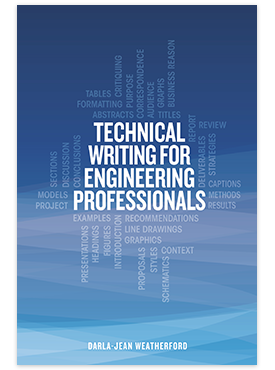Interview with Darla-Jean Weatherford
5 QUESTIONS FOR DARLA-JEAN WEATHERFORD
AUTHOR OF TECHNICAL WRITING FOR ENGINEERING PROFESSIONALS
PennWell Books: What made you decide to write a book?
Darla-Jean Weatherford: I taught technical writing in petroleum engineering at Texas A&M for more than 20 years, and from time to time students would come back to campus and comment that they wished they had a book that showed their minions how to write the way I had taught them. I did it on the off chance that it would be useful to others, too.
PennWell Books: What sets your technical writing book apart from the others?
Darla-Jean Weatherford: My book doesn't pretend to be a textbook for a university technical writing class; it attempts to provide pretty much a step-by-step guide
to writing technical papers for professional purposes. I think my approach to writing those papers is a bit different from most in that I urge writers to start at the end of the project and to keep the conclusions before them as they write every section of the paper.
In all of my education in technical writing, I heard repeatedly that reports need to have the "bottom line up top" (which is great business practice, anyway, and engineering is indeed a business). But in my decades as a technical editor of engineering papers, I continually saw writers starting with project history or long explanations of the problem they set about to solve or nearly anything except what they found and why those results matter to the readers. I think that comes largely from advice to "write as you go," presumably so the report will be finished soon after the project is done.
But that means writers start on the paper before they know the conclusions of the project, and they're likely to waste a great deal of time (both theirs and the readers') writing stuff that, in the long run, doesn't really matter. I agree that the readers need to know enough of the background to understand why the project is important,
but they don't usually need the history of the world--and too many writers give them that.
Instead, we need to acknowledge that readers today are stressed out and in a hurry. They may not read more of the report than they can get on a couple of screens on their smart phones, and in that little space, they need to know what the project found and why it matters.And every bit of the rest of the report needs to provide support for
those 2 things: concrete evidence that "what it found" is defensible enough for the company to act on it appropriately and "why it matters" is clear enough for them to do it (or not).
That means writers need to know what they found and why it matters before they start to struggle with the writing (which engineers may not like to do very much, anyway). In the long run, when they can limit the report to just what their readers need, I think they'll find they can write it faster and easier, and their readers will appreciate them more.
And it means they need to forget about those classroom assignments to write a paper that is at least X pages long and instead write the paper to fit the project and the readers. Sometimes a single paragraph is all we need.
I don't think other books focus on those much.
PennWell Books: In your opinion, who would gain the most from reading your book?
Darla-Jean Weatherford: The book is written with engineering professionals in mind, but I developed the methodology over years of teaching in a public university setting. I started with lab reports in an undergraduate class and some general ideas about how to write technical papers, and I was lucky to be able to work with an industry leader, Steve Holditch, early in my career. Steve was already insisting that engineering reports in his company start with a short, clear summary of the whole report and that the conclusions come early enough for readers to find them easily.
Steve put conclusions after the introduction. I had my students doing that for a while, but then one brilliant young man formatted his right after the abstract--which is why I call my approach "writing on ACID"--so that readers could find the short summary--including what he found and why it mattered--immediately before the conclusions, with
the introduction and discussion farther down in the paper. Abstract--Conclusions--Introduction--Discussions=ACID.
PennWell Books: What is your biggest pet peeve when it comes to other people’s
writing?
Darla-Jean Weatherford: Not knowing what they found and why it matters; one of the most frequent questions I ask authors is "So what?" If the authors can't answer that, how can they expect readers to relate to their work?
Or not finding the evidence to support their claims. If you want to tell me that a petroleum reservoir is unlikely to be economical after a certain number of years, show me the trends you expect production to follow and show me where the economic limit is. If you want me to believe your tool finds corrosion in pipe better than another tool does, show me the models of what both tools show.
Or making claims for the future. Your new tool may well revolutionize the industry, or it may not. Don't tell me it will.
PennWell Books: What is your favorite book to read? Or who is your favorite author?
Darla-Jean Weatherford: Hmmmm....hardest question of all for me to answer. When I was teaching full time and grading 150 or more papers a week (in addition to editing several professional reports a month), I didn't read much of anything for pleasure because I spent a lot of my time being cross-eyed from the grading and editing. Now that I'm retired, I find myself reading classics; the last book I read was T.H. White's The Once and Future King, and now I'm in the middle of Beowulf.


